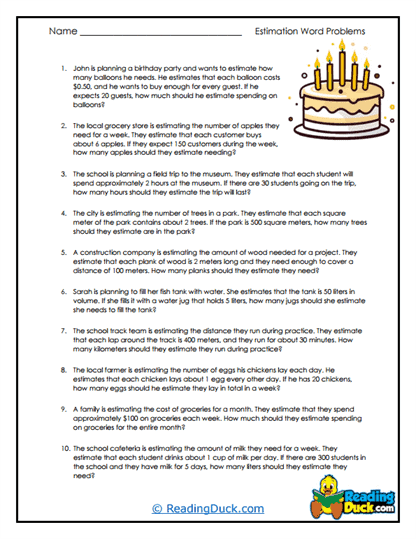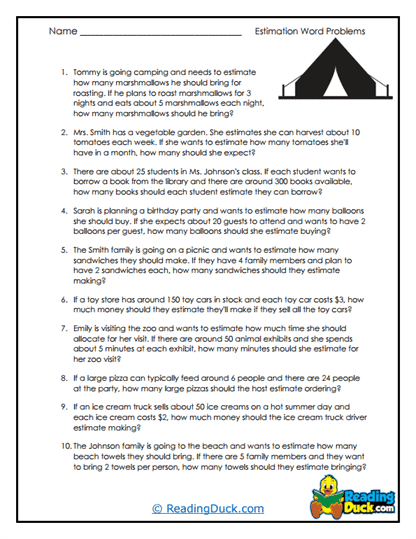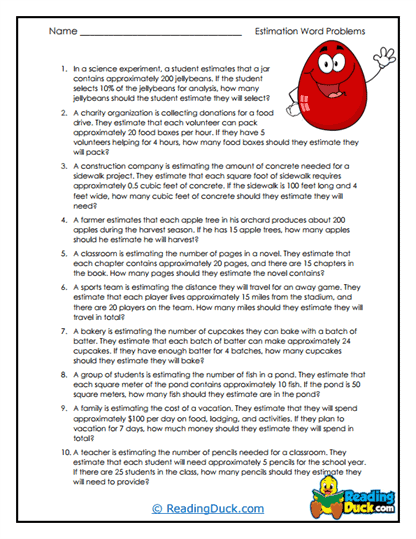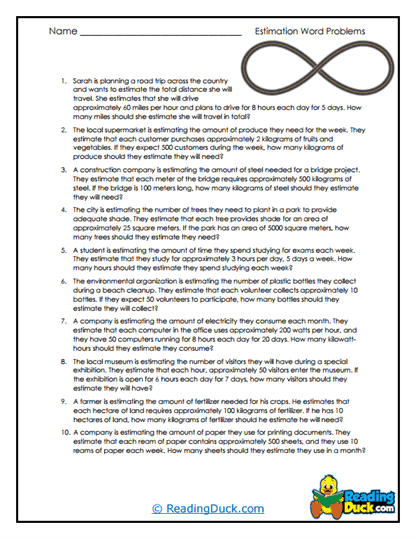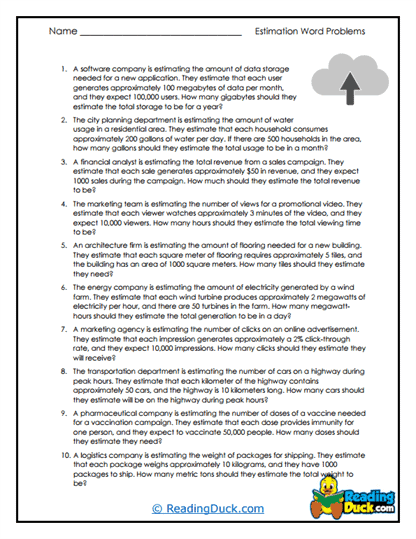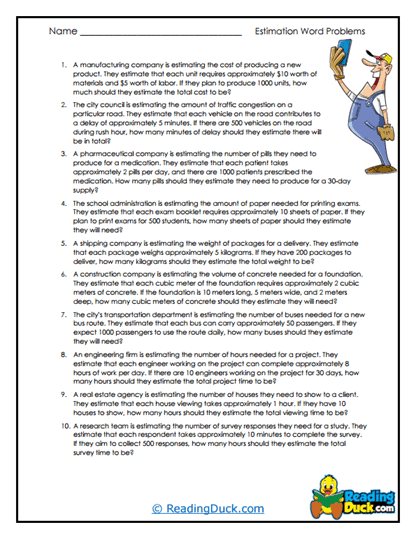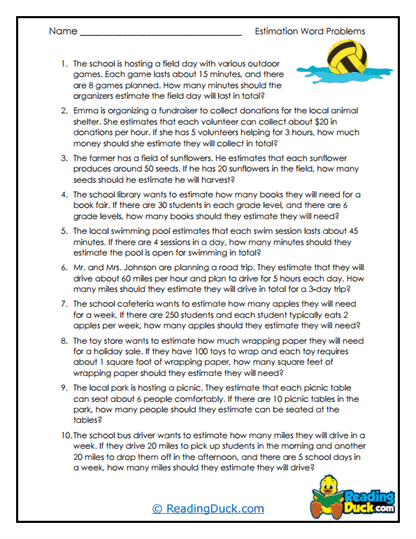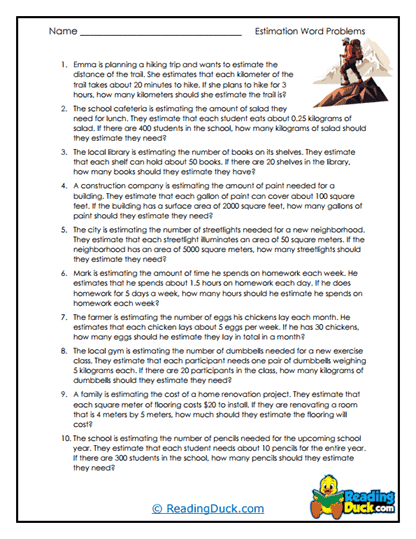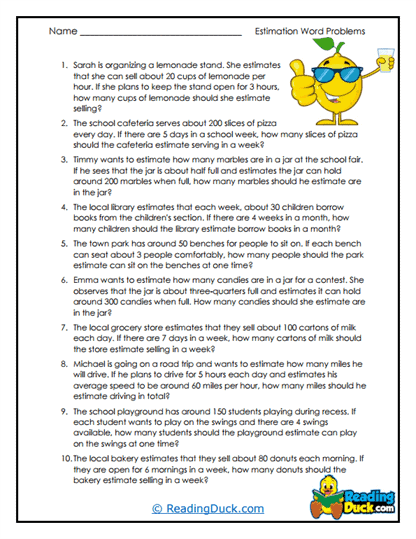Estimation Word Problems Worksheets
About Our Estimation Word Problem Worksheets
Our collection of Estimation Word Problems worksheets offers students a practical and engaging way to develop their estimation skills through real-world scenarios. These worksheets are a subtopic under the broader category of Math: Word Problems and are designed to help students build confidence in making reasonable guesses, approximations, and judgments in mathematical contexts. Each worksheet set is crafted to reinforce estimation concepts while also enhancing students' reading comprehension and critical thinking abilities.
Each worksheet set includes:
- Multiple Choice Questions: These questions assess students' understanding of the reading passage by providing several answer options, helping them reinforce key concepts related to estimation within different contexts.
- Short Answer Questions: In this section, students are required to write out their answers, encouraging them to express their thought processes and solidify their understanding of how to approach estimation word problems.
- Open-Ended Questions: These questions prompt students to offer personal input, opinions, or reflections related to the scenarios in the word problems. This format allows students to connect mathematical concepts to their own experiences, making the learning process more meaningful and engaging.
An answer key is provided for every question sheet, making it easy for teachers and parents to review and assess students' work. All of the worksheets are available as PDF files, which can be easily viewed electronically, downloaded, and printed out for use in classrooms or homeschool settings.
Mastering Estimation: The Art of Making Educated Guesses
Estimation is a fundamental mathematical skill that involves making an educated guess or approximation rather than calculating an exact answer. It is particularly useful in situations where precision is not necessary, or when a quick, reasonable answer is needed. Estimation word problems are a great way to teach students how to apply this skill in practical, real-world contexts. When introducing estimation word problems, it's important to explain the concept in a clear, engaging way that encourages students to see the value of estimation in everyday life.
What Are Estimation Word Problems?
Estimation word problems are mathematical exercises that challenge students to approximate the answer to a problem based on the information provided. Instead of calculating the exact result, students use rounding, mental math, and reasoning to arrive at an answer that is close enough to be useful. These problems often involve scenarios where students must estimate quantities, totals, or averages, making them more relatable and applicable to real-life situations.
Why Are Estimation Word Problems Important?
- Developing Number Sense: Estimation helps students develop a strong number sense by encouraging them to think about numbers in a more flexible way. Instead of focusing solely on exact calculations, students learn to recognize when an answer is reasonable and how different numbers relate to one another.
- Practical Applications: Estimation is a skill that students will use throughout their lives, from budgeting and shopping to measuring and planning. By practicing estimation in word problems, students learn how to make quick, informed decisions in everyday situations where precision is not necessary or feasible.
- Enhancing Problem-Solving Skills: Estimation word problems require students to think critically about how to approach a problem. They must analyze the information given, decide which numbers are important, and determine how to approximate the answer. This process helps develop essential problem-solving skills that are valuable in both academic and real-world contexts.
Key Components of Estimation Word Problems
- Understanding the Problem: The first step in solving an estimation word problem is understanding the scenario and identifying the key pieces of information. Students need to determine what is being asked and which numbers are relevant to making an estimate.
- Choosing a Strategy: Students must decide on an appropriate strategy for making their estimate. This could involve rounding numbers to the nearest ten or hundred, using mental math to approximate sums or differences, or making a rough calculation based on the given information.
- Making the Estimate: Once a strategy is chosen, students apply it to make their estimate. This step encourages them to think about how accurate their estimate needs to be and whether it makes sense in the context of the problem.
- Interpreting the Result: After making their estimate, students should interpret the result within the context of the problem. They need to ensure that their estimate is reasonable and that it answers the question posed by the problem. This step helps students connect their mathematical reasoning to real-world situations.
Common Scenarios in Estimation Word Problems
- Rounding Numbers: These problems involve rounding numbers to the nearest ten, hundred, or thousand to make an estimate. For example, a problem might ask students to estimate the total cost of groceries by rounding each item’s price to the nearest dollar.
- Approximating Totals: Some word problems require students to estimate the total of several numbers. For instance, students might be asked to estimate the total number of attendees at an event based on early ticket sales.
- Estimating Averages: Estimation word problems can also involve finding approximate averages. For example, a problem might ask students to estimate the average number of points scored by a team over several games, based on the given scores.
Creative Ideas for Using Estimation Word Problems Worksheets
Teachers and parents can use these Estimation Word Problems worksheets in a variety of creative and effective ways to enhance students' learning experiences. Here are some ideas on how to incorporate these worksheets into your educational curriculum:
1. Integrating Estimation with Real-Life Scenarios
- Practical Estimation Applications: Encourage students to relate estimation to their everyday lives by solving problems that mimic real-world situations. For example, create word problems that involve estimating the total cost of a shopping trip, the number of supplies needed for a project, or the time required to complete a task. These activities help students see the relevance of estimation in daily life and make the learning process more engaging.
- Cross-Curricular Connections: Use estimation word problems to connect math with other subjects such as science, social studies, or language arts. For instance, you can create word problems that involve estimating quantities in a science experiment, such as the number of seeds needed for a garden, or estimating distances on a historical map. This approach not only reinforces estimation skills but also shows students how math is interconnected with other areas of knowledge.
2. Group Activities and Collaborative Learning
- Pair Work: Have students work in pairs to solve estimation word problems. One student can read the problem aloud while the other writes down the estimate, then they can switch roles. This collaborative approach encourages communication, teamwork, and helps students learn from each other's estimation strategies.
- Math Centers: Set up a math center in your classroom where students can work on estimation word problems independently or in small groups. Provide manipulatives like number lines, counters, or estimation jars filled with objects to help them visualize their estimates. This hands-on approach is particularly beneficial for visual and kinesthetic learners who need to see and touch to understand.
3. Real-Life Projects and Applications
- Estimation in Shopping: Have students create a mock shopping list and use estimation to determine the total cost of their items. They can round the prices of each item to the nearest dollar or ten dollars to make their estimate. This project helps students see the practical applications of estimation in everyday life, such as budgeting and financial planning.
- Field Trip Estimation: If you take your students on a field trip, incorporate estimation word problems related to the trip. For example, if you visit a museum, you could create problems about estimating the number of exhibits in a gallery or the total number of visitors on a busy day. This makes math learning more dynamic and tied to real-world experiences, helping students see the relevance of estimation outside the classroom.
4. Personalized Learning and Differentiation
- Tailored Problems: Customize the estimation word problems to match the individual needs and abilities of your students. For struggling learners, simplify the problems by using smaller numbers or more straightforward scenarios. For advanced learners, increase the complexity by introducing multi-step problems or additional variables. Differentiating the worksheets ensures that all students are appropriately challenged and engaged at their level.
- Student-Created Problems: Encourage students to write their own estimation word problems based on their interests and experiences. They can then exchange problems with classmates to solve. This not only makes learning more personalized and relevant but also helps students take ownership of their math practice. It’s a great way to deepen their understanding by seeing how estimation applies to their own lives.
By using these Estimation Word Problems worksheets creatively, teachers and parents can help students develop a strong foundation in estimation while also enhancing their problem-solving abilities, number sense, and real-world application of math. These worksheets are not just about practicing estimation; they are about making estimation a meaningful and engaging part of students' everyday lives. Through real-world scenarios and interactive learning approaches, students can see the practical applications of their mathematical knowledge, building confidence and enthusiasm for math.
